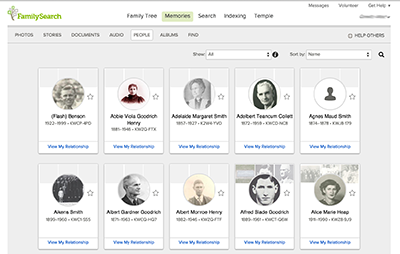New Features You’ll Find at FamilySearch.org
Contributed By R. Scott Lloyd, Church News staff writer
.jpg)
New FamilySearch features make it easier for users to find records and record memories of their ancestors.
Article Highlights
- FamilySearch’s new record hints assist users in finding the correct records to match with their ancestors.
- FamilySearch also has various new apps to assist in the family history process, as well as a Memories section to help record memories of ancestors.
Related Links
FamilySearch.org, as it grows and develops, can help family history enthusiasts meet their goals in this and coming years, a speaker at the recent RootsTech 2015 family history conference in Salt Lake City said.
“FamilySearch is changing, and you should expect it to,” declared Devin Ashby, a project manager in the records division of FamilySearch International, as he conducted a class February 12 on the topic “What’s New at FamilySearch?” Brother Ashby highlighted a number of innovations and services that are relatively new to FamilySearch.org.
Various Pedigree Views
Website visitors can view their family pedigrees in a traditional view, as a fan chart, and as a portrait chart showing photos of ancestors that have been submitted to FamilySearch by relatives of the visitor. With a descendency chart view, a website visitor can see an ancestor’s descendants and in this way might spot ancestral lines to which new information can be added. The charts can be printed out and shared with family members or others. Brother Ashby said he heard of one user who makes place mats from her ancestral fan chart so her children can have dinner with their ancestors.
Record Hints

The Memories section of FamilySearch.org features photos of ancestors that have been submitted to FamilySearch, either by oneself or one’s relatives.
With a feature introduced about a year ago, FamilySearch automatically compares individuals in a visitor’s ancestry with its vast database of indexed records—the indexing having been accomplished by FamilySearch volunteers—and then offers “hints” of records the user might access.
If the hinted record is indeed a match, information from the record can then be added to one’s family tree. Record Hints can be accessed from two places in the Family Tree section of FamilySearch: the descendency view of a pedigree chart or an individual ancestor’s details page.
“You power the hinting engine in the tree,” Brother Ashby said to those in the audience who by show of hands identified themselves as volunteer indexers. “And you do so much to help so many people make connections.”
FamilySearch Apps
“The family history center now is on your smartphone if you download apps,” Brother Ashby said, referring to FamilySearch Tree and FamilySearch Memories, both of which can be downloaded free from Apple’s App Store or Google Play.
“You can carry your collections and resources with you wherever you go,” he said. He spoke of his mother-in-law, who had entertained his children with a hilarious tale of being chased by a moose. He said he brought forth his smartphone and asked her to retell the story as he recorded her voice with his children interacting with her. He then entered the recording with her photo on FamilySearch, and his children and future posterity can now experience her telling of the story.
Memories
The “Memories” section of FamilySearch allows the uploading of photos and stories pertaining to family members and ancestors. To illustrate the value of it, Brother Ashby conducted an exercise with his audience, asking them to write as many “I remember” statements as possible in 90 seconds, such as “I remember my first baseball game.” He then suggested that such memories could be plotted on a map. He said he conducted that activity with one of his daughters, who was able to come up with a number of memories that could then be shared on FamilySearch.
“When you upload photos, be sure to tag who they are, and be sure to link them to people in your tree,” he urged. “Then the memories are perpetuated down the generations.” Stories can be obtained in a number of ways, Brother Ashby said: speaking into a smartphone and uploading the recording; copying and pasting from a computer word processing document; extracting an account from an email message.
“My parents are living in London, and my dad shared an experience in an email I thought was hilarious,” he said. “I copied it out of the email, put it in FamilySearch, added a photo of them living in London. I have a memory. Now, when I’m older and my kids are older, I’ll say, ‘This is how your grandpa used to talk; he’s really a funny guy.’”
Regarding privacy, Brother Ashby said that in Family Tree, all of the information for living people is private and can be accessed only by family. Items in the Memories section, such as a photo or an audio file, can be made accessible to a wider audience. Brother Ashby said records are being added to FamilySearch through the indexing of obituaries, which often yield many names and relationships with even one obituary. Also, some 170,000 family history books have been digitally imaged and published on FamilySearch for free.
Video recordings of Brother Ashby’s presentation and other selected sessions from the 2015 RootsTech conference can be viewed at the conference website, www.rootstech.org.
The largest genealogical organization in the world, FamilySearch is sponsored by the Church, Brother Ashby noted, an outgrowth of the Genealogical Society of Utah founded in 1894. FamilySearch.org is the Internet website provided by FamilySearch International. “FamilySearch is powered by volunteers,” he said. “This is a sharing community; it’s sharing, and it’s caring.” It is also a nonprofit organization that provides its services for free.
